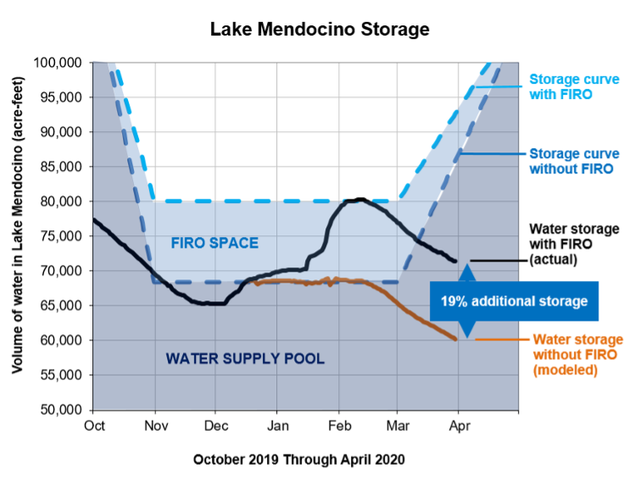What is Forecast Informed Reservoir Operations (FIRO)?
Forecast Informed Reservoir Operations (FIRO) is a flexible water management approach that uses data from watershed monitoring and improved weather forecasting to help water managers selectively retain or release water from reservoirs for increased resilience to droughts and floods. FIRO applies emerging science and technology to optimize water resources and adapt to climate change without costly infrastructure.
The Case for FIRO at Lake Mendocino
Lake Mendocino has experienced significantly reduced water supply reliability since diversions from the Eel River were decreased in 2006. The goal of FIRO at Lake Mendocino is to update the 1950s-era Water Control Manual by applying forecasting advancements to increase water supply reliability without reducing - and while possibly enhancing - the existing flood protection capacity of Lake Mendocino and downstream flows for fish habitat.
FIRO Delivers Significant Benefits
Flooding and water supply in the Russian River basin are driven almost entirely by atmospheric rivers (ARs), so the success of FIRO at Lake Mendocino depends on research to improve AR forecasts. A large body of work, led by the Center for Western Weather and Water Extremes (CW3E) at Scripps Institution of Oceanography, has enabled FIRO at Lake Mendocino. CW3E’s work includes the AR Reconnaissance program, which fills major gaps in observations over the ocean to improve the accuracy of forecast models.
 Results from Operational Testing at Lake Mendocino
Results from Operational Testing at Lake Mendocino
USACE experimented with FIRO with planned major deviations from the Water Control Manual during water years (WYs) 2019 and 2020. In both years, FIRO increased water supply benefits and managed flood risks. In 2020, FIRO increased water storage by nearly 20 percent, roughly equivalent to the water used by 22,000 households.
Transferability to Other Reservoirs
FIRO is being assessed at Prado Reservoir, New Bullards Bar Reservoir, and Lake Oroville in California, as well as the Howard Hanson Dam in Washington. Lessons learned from these projects will be incorporated into a screening tool to help prioritize FIRO assessments at other sites across the United States.
Final Viability Assessment
The Final Viability Assessment (FVA) is the culmination of a six-year effort led by the Lake Mendocino Forecast Informed Reservoir Operations (FIRO) multi-agency Steering Committee. The FVA demonstrates the viability of FIRO and provides strong support for the U.S. Army Corps of Engineers (USACE) to approve and adopt FIRO-based operations at Lake Mendocino, located in the Russian River watershed in northern California.
